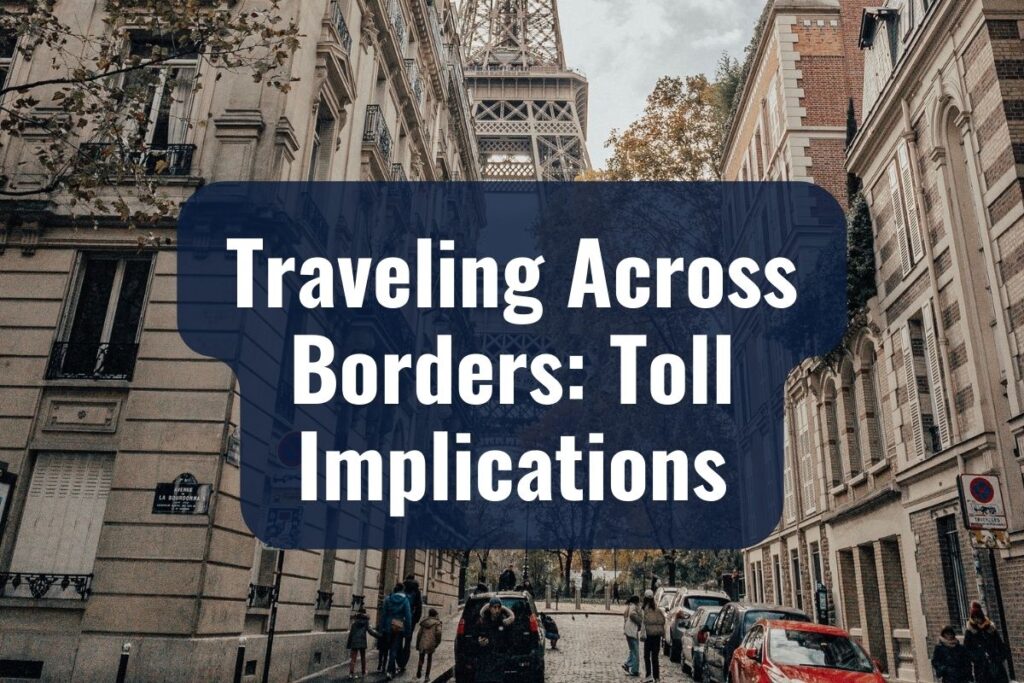Whether you’re driving through the scenic countryside, bustling cities, or across borders, understanding the toll system is essential for a smooth and stress-free journey. This guide aims to simplify the process, offering clear and concise information about the toll system in France.
In this guide, we’ll explore the various aspects of French toll roads, including an in-depth look at different types of tolls, vehicle classification, and associated costs.
KEY TAKEAWAYS
- French toll roads are essential for maintaining quality infrastructure, with costs shared by users.
- Toll fees in France vary by vehicle type, with heavier vehicles generally incurring higher charges.
- Payment options at toll booths include cash, credit/debit cards, and the convenient telepeage system.
- The telepeage system offers a time-saving, automatic toll payment method via an electronic transponder.
- Discount plans and subscriptions can provide significant savings for frequent toll road users.
- Navigating toll stations smoothly requires attentiveness to signage and preparedness with payment.
Understanding the French Toll System
The concept of toll roads in France is not just a modern convenience but a historical practice with deep roots. Originating centuries ago, toll roads have evolved significantly to support the nation’s infrastructure.
Today, they play a crucial role in maintaining and upgrading road networks, ensuring that travelers can enjoy safe and well-maintained routes across the country.
How Toll Roads Operate in France
In France, toll roads are primarily found on autoroutes (motorways), which various private companies manage under government concessions. These companies are responsible for the upkeep, modernization, and safety of these roadways.
In exchange, they are authorized to collect tolls from road users. This system ensures that the cost of maintaining high-quality road infrastructure is shared among those who use it, rather than being solely funded by taxpayers.
Locating Toll Roads in France
Toll roads in France are strategically located, primarily covering long-distance routes and areas with heavy traffic. These include major motorways connecting cities and regions, bridges, and tunnels with significant construction and maintenance costs.
Knowing where these tolls are located is vital for effective trip planning. Most GPS systems and online maps offer the option to show toll roads, helping drivers anticipate and prepare for any toll charges on their route.
Types of Tolls and Toll Roads

France offers a diverse range of toll roads, each with its unique characteristics and tolling methods. Understanding these variations is key to navigating the French road system efficiently.
Different Toll Road Types
The most common type of toll road in France is the autoroute, equivalent to a motorway or freeway. These roads are designed for long-distance travel, offering high-speed limits and fewer stops.
In addition to autoroutes, some specific bridges and tunnels also impose tolls, particularly those with significant construction and maintenance costs.
Variable Tolling: Understanding the Differences
Toll charges in France can vary based on several factors. One primary consideration is the type of road. Autoroutes, being high-speed and well-maintained, often have higher tolls than bridges and tunnels.
Another factor is the time of day or season. Some toll roads may charge higher rates during peak travel times or tourist seasons to manage traffic flow and maintenance needs.
Understanding these types of tolls and their variable nature is crucial for planning your journey across France. This knowledge helps not only budget travel expenses but also choose the most cost-effective routes for your trips.
Vehicle Classification and Toll Costs
In France, toll costs are not one-size-fits-all; they vary depending on the type of vehicle you are driving. Understanding this classification system is crucial for accurately estimating your travel expenses.
| Vehicle Category | Description | Typical Toll Fee Implication |
| Category 1 | Standard vehicles (cars, motorcycles) | Lowest toll fees |
| Category 2 | Vehicles over 2m and under 3m (small trucks, vans) | Slightly higher fees |
| Categories 3 & 4 | Large vehicles (buses, heavy trucks) | Highest fees |
Understanding Vehicle Classification
The French toll system categorizes vehicles primarily based on their height and number of axles. The primary categories are:
Category 1: Standard vehicles, typically cars and motorcycles, with a height less than or equal to 2 meters.
Category 2: Includes vehicles with a height exceeding 2 meters but less than 3 meters, often comprising small trucks and vans.
Category 3 and 4: These categories are reserved for larger vehicles such as buses, heavy trucks, and vehicles with multiple axles.
General Guidance on Toll Costs
Toll costs for different vehicle types are set to reflect the wear and tear they inflict on the road. Generally, the larger and heavier the vehicle, the higher the toll fee. For example:
- Cars and motorcycles (Category 1) typically incur the lowest toll fees.
- Small trucks and vans (Category 2) have slightly higher fees.
- Large trucks and buses (Categories 3 and 4) are charged the highest fees due to their size and impact on the roads.
It’s important to note that these are general guidelines, and exact toll fees can vary based on the specific toll road and distance traveled.
Payment Methods

Navigating the payment options for tolls in France is an essential aspect of your travel. Familiarizing yourself with these methods ensures a smooth and efficient passage through toll booths.
Cash and Card Payments
Cash Payments: Most toll stations accept cash, but it’s crucial to have small denominations or coins, as making change for large bills can be challenging.
Credit/Debit Cards: Cards are widely accepted at toll booths. Look for lanes marked with a card symbol. Ensure your card is enabled for international transactions if you’re using a non-French bank card.
Automated Toll Booths
Automated toll booths are a common sight on French toll roads. These booths allow for quick payment without human interaction. They typically accept both credit/debit cards and cash. Ensure you choose the correct lane based on your preferred payment method.
Telepeage System: A Convenient Alternative
The telepeage system is a highly convenient option, especially for those frequently using toll roads in France. It involves using an electronic transponder attached to your vehicle’s windshield.
How it Works: The transponder automatically communicates with the toll booth, allowing for seamless passage without stopping for payment.
Obtaining a Transponder: Transponders can be obtained from various service providers and are typically linked to a credit card for automatic billing.
Tips for Smooth Transactions
- Always check the symbols at toll lanes to choose the correct payment method.
- Keep some cash handy in case of card payment issues.
- Consider the telepeage system for frequent travel.
Telepeage Systems: A Convenient Option
For those who find themselves frequently navigating the toll roads of France, the telepeage system emerges as an invaluable asset, streamlining the toll-paying process significantly.
What is Telepeage?
Telepeage is an electronic toll collection system designed to make your travel through toll booths faster and more convenient. It utilizes a small electronic transponder, which you can attach to your vehicle’s windshield.
As you approach a toll booth, the system automatically detects the transponder, processes the toll fee, and allows you to pass through without stopping.
Obtaining a Telepeage Transponder
Where to Get One: Telepeage transponders can be obtained from several service providers in France. They are available at major toll plazas, online, and at certain retail outlets.
Registration Process: The process involves registering your vehicle and linking the transponder to a payment method, usually a credit card. There are options for both French residents and visitors, so make sure to choose a plan that suits your length of stay and frequency of travel.
Advantages of Using Telepeage
Time-Saving: By allowing for seamless passage through toll booths, telepeage saves valuable time, especially during peak travel hours or on busy routes.
Convenience: There’s no need to fumble for cash or wait in line at manual payment lanes.
Flexibility: Telepeage transponders are generally compatible with most toll roads throughout France, offering nationwide coverage.
Setting Up Your Telepeage Transponder
Installation: Simply attach the transponder to your vehicle’s windshield following the provided instructions.
Account Management: You can manage your account online, keeping track of toll expenses and updating payment information as needed.
Toll Discounts and Subscriptions

Exploring avenues for toll discounts and subscription plans can lead to significant savings, especially for those who frequently travel on French toll roads.
Available Toll Discounts
Frequent Traveler Discounts: Some toll operators offer discounts for frequent users. This usually involves a loyalty program where accumulated travel leads to reduced toll rates.
Off-Peak Discounts: Discounts may be available for traveling during off-peak hours. This not only helps you save money but also reduces traffic congestion during busy periods.
Special Group Discounts: Discounts might be available for certain groups such as large families, students, or senior citizens. It’s worth checking with individual toll operators for such offers.
Subscription Plans
Telepeage Subscriptions: In addition to simplifying the payment process, telepeage services often come with subscription plans that offer reduced rates or flat-fee options for unlimited travel within certain periods.
Seasonal Passes: For those staying in France for an extended period, seasonal passes can offer unlimited access to certain toll roads for a set fee, providing substantial savings over standard toll rates.
How to Qualify and Apply
Eligibility Criteria: Each discount or subscription plan comes with its own set of eligibility criteria. It’s important to review these to determine which plan best fits your travel needs.
Application Process: Applications can usually be completed online or at customer service centers located at major toll plazas. Be prepared to provide necessary documentation, such as vehicle registration and identification.
Maximizing Your Savings
Compare Plans: Take the time to compare different plans and discounts offered by various toll operators.
Stay Informed: Keep an eye on promotions or changes to discount programs, which can lead to additional savings.
Successfully navigating toll stations is a key aspect of driving on French toll roads. These practical tips will help ensure a smooth and stress-free experience at toll booths.
Approaching Toll Stations
Be Alert for Signage: As you approach a toll station, pay close attention to the signs indicating different lanes for various payment methods or telepeage users.
Choose the Correct Lane: Select the lane based on your payment method—cash, card, or telepeage. Lanes for telepeage users are usually marked with a special symbol (usually a “t”).
At the Toll Booth
Prepare Your Payment: If paying by cash or card, have your payment ready to avoid delays. For telepeage users, ensure the transponder is properly installed and visible.
Interacting with Booth Personnel: If you need to interact with booth personnel, be courteous and patient. Remember, language barriers can sometimes cause confusion, so clear and simple communication is key.
Common Issues and Solutions
Receipts for Payment: Always collect a receipt, especially if you’re traveling for business or need records for expense claims.
In Case of Payment Issues: If your card is declined or you face issues with cash payment, press the help button at the booth for assistance.
Telepeage Malfunctions: If your telepeage transponder doesn’t work, move to a manual lane and explain the situation to the booth attendant.
Exiting the Toll Station
Proceed with Caution: Once your payment is processed, the barrier will lift. Proceed cautiously, merging back into the traffic flow.
Traveling Across Borders: Toll Implications

When your journey takes you beyond France’s borders, understanding the toll implications is essential for seamless international travel.
Toll Systems in Neighboring Countries
Varied Systems: Each neighboring country has its toll system, which can differ significantly from France’s. For example, some countries use a vignette system (a pre-paid sticker), while others have toll booths similar to France.
Research Before Travel: It’s advisable to research the toll system of your destination country beforehand. This preparation can help avoid surprises and ensure you have the correct payment method.
Special Considerations for Multi-Country Travel
Telepeage Compatibility: While the French telepeage system is convenient within France, it may not be compatible with toll systems in other countries. Always check whether your telepeage transponder is accepted in the countries you plan to visit.
Currency and Payment Methods: Be prepared to deal with different currencies and payment methods. Some toll booths in neighboring countries may not accept credit cards, so having some cash in the local currency can be helpful.
Expect Delays: Border crossings can be busy, especially during peak travel times or holidays. Allow extra time for potential delays.
Documentation and Customs: Ensure you have all necessary travel documents, including passports and vehicle paperwork, easily accessible.
Apps and Resources for International Toll Roads
Utilize apps and digital resources that provide information on international toll roads, including costs and payment methods. These tools can be invaluable for planning your route and budget.
By keeping these considerations in mind, you can navigate toll roads across borders with confidence, enhancing your international driving experience. In the final section of our guide, we will provide additional resources and support to further assist your travels on French toll roads.
Additional Resources and Support
Official Toll Road Websites: Most French toll road operators have official websites offering detailed information about toll rates, payment methods, and vehicle classification. These sites often provide route planners, fare calculators, and customer service contacts.
Government Travel Sites: French government travel and transportation websites are valuable resources for up-to-date information on road regulations, toll systems, and cross-border travel guidelines.
Navigation Apps: Apps like Google Maps, Waze, and ViaMichelin can help you plan your route, showing toll roads and estimated toll costs. Some apps also offer the option to avoid toll roads if desired.
Telepeage Service Apps: If you’re using a telepeage transponder, the service provider’s app can offer insights into your toll road usage, expenses, and account management.


